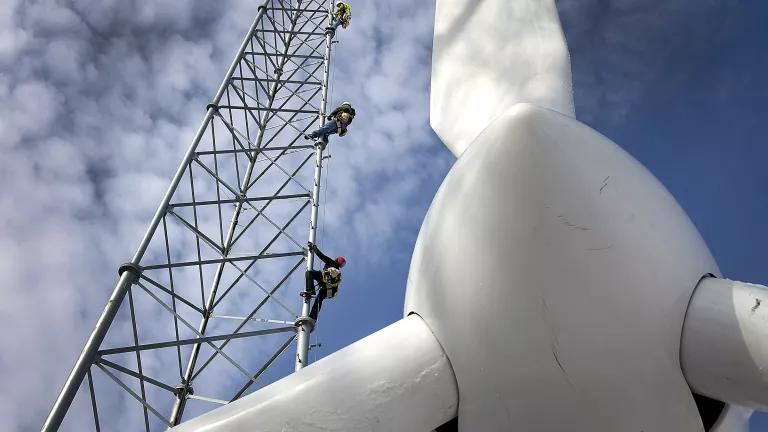President Biden’s Budget Provides Climate Vision
We encourage Congress to meet the ambition of this vision to tackle the energy and climate crises—and improve lives while doing so.

A Polaris Industries wind turbine in Elgin, Minnesota
If the president’s annual budget is a statement of values, then President Biden’s Fiscal Year (FY) 2023 Budget clearly shows that this administration ranks tackling climate change and protecting people and communities at the top of its agenda. Along with a strong focus on deficit reduction and addressing energy in these challenging times, this budget will be a mark that Congress should seriously consider.
In a dramatic departure from the weak international climate funding that Congress included in its appropriations package that was recently signed into law, the president’s budget includes international climate investments that could lead to critical emissions reductions while helping the most vulnerable and demonstrating American leadership. The overall budget includes $11 billion in total international climate finance, with $5.3 billion in appropriated investments and more than $5.5 billion in development finance and credit programs. Brendan Guy and Jake Schmidt unpack the international investments and what this means for our role on the world stage here.
Overall, the president’s budget invests a total of $44.9 billion to tackle the climate crisis, a $16.7 billion increase from FY 2021. The budget also includes increases for agencies still struggling to operate at full capacity since being hobbled by the Trump administration. To set the bar for that restoration, the budget includes $11.9 billion for the Environmental Protection Agency (EPA), which is a 29 percent increase from the 2021 enacted level. The Department of the Interior (DOI) budget proposal is $17.5 billion (a 19.3 percent increase from the 2021 enacted level). The Bureau of Land Management and the Fish & Wildlife Service would also see increases in this proposal.

A solar panel array installed by Cypress Creek Renewables on a farm in Thurmont, Maryland
The Department of Energy (DOE) budget is a proposed $48.2 billion in funding, which is $6.3 billion (or 15.1 percent) above the 2021 enacted level. What’s critical here is that this additional funding includes investments in clean energy, environmental justice, and efficiency upgrades, including:
- $502 million for DOE programs to weatherize and retrofit low-income homes, including $100 million for a new Low-Income Home Energy Assistance (LIHEAP) Advantage pilot to electrify and decarbonize the homes of those who rely most on LIHEAP funding;
- $34 million for the Office of Economic Impact and Diversity for implementing the department’s Justice40 efforts and equity action plan; and
- Increases throughout the budget in science and clean energy research and development.
According to a White House fact sheet, “President Biden is committed to decreasing energy costs for households, including in rural, tribal, and disadvantaged communities.” This bears out in a number of key investments including:
- $900 million across Housing and Urban Development (HUD) programs for modernization activities at HUD-assisted properties, aimed at improving energy efficiency and resilience to climate change impacts;
- $21.1 billion for public transportation, including $4.5 billion to deliver new high-quality rail or bus rapid transit to more communities, saving them money and reducing our dependence on oil; and
- More than $9 billion for programs and initiatives across the federal government that support economic revitalization and job creation in energy communities.
The international climate budget is split between several agencies and tools, with a proposed $11 billion total. This includes critical investments of:
- $2.3 billion for bilateral renewable energy, sustainable landscapes, and adaptation strategies at the State Department and U.S. Agency for International Development;
- $1.6 billion for the Green Climate Fund (GCF, which should be funded at a significantly higher level); and
- $5.5 billion for strategies to unleash investments from the Millennium Challenge Corporation (MCC), International Development Finance Corporation (DFC), Export-Import Bank (EXIM), and multilateral funds.
Additional investments aimed at tackling climate change and improving lives include $757 million for zero-emission fleet vehicles and supporting charging infrastructure, and $20 million for the Department of Labor to partner with AmeriCorps and other agencies to establish a Civilian Climate Corps program.

Workers installing a charging system for electric buses in Honolulu, Hawai’i
Though not everything can be perfect, this budget provides $4 billion for the EPA’s water infrastructure programs, compared to about $3 billion last year. While it’s important that these programs are continuing to increase, they still fall far short of what we need to address our nation’s water and wastewater infrastructure crisis, even taking into account the additional funding provided by the Infrastructure Investment and Jobs Act (aka Bipartisan Infrastructure Law or BIL). We need to keep building on the progress made in the BIL by increasing our investment in these critical resources.
Overall, however, this budget proposal provides the much-needed vision and ambition we need to tackle the most pressing problems we are facing, with climate change at the top of the list. We encourage Congress to take this budget proposal to heart and meet the ambition outlined here to tackle the energy and climate crises and improve lives while doing so.




